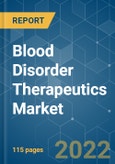The Blood Disorder Therapeutics Market is expected to register a CAGR of 6.2% during the forecast period. Blood disorders are conditions that impact the blood's ability to function correctly. It includes problems with the white blood cells, red blood cells, platelets, bone marrow, spleen, lymph nodes, and the proteins which are involved in bleeding and clotting (hemostasis and thrombosis). Most of the blood disorders are caused by mutations in specific genes and can be passed down in families. According to the National Heart, Lung, and Blood Institute, Hemophilia A is the most common type of the disease in males then females about 1 in 4,000 to 1 in 5,000 males worldwide are born with Hemophilia A disorder and Hemophilia B occurs in approximately 1 in 20,000 newborn males worldwide. As per study published in the PLOS Medicine Journal, sickle cell anemia cases are expected to increase about 30 percent globally by the year 2050. Rising prevalence of various blood disorders and increasing investment in research and development for advance treatment options are the key driving factors in blood disorder therapeutics market.
Key Market Trends
Recombinant Factors Segment is Expected to Hold a Significant Market Share in the Blood Disorder Therapeutics Market
- Worldwide, the rising prevalence of blood disorders and increasing adoption of recombinant factor concentrates are the key drivers of the recombinant factors segment.
- A recombinant factor is a form of blood factor that is manufactured via recombinant technology. Recombinant factors are used in the treatment of disorders such as hemophilia (prevention and control of hemorrhagic episodes).
- According to the World Federation of Hemophilia Report, in the year 2017, worldwide around 315,423 people are affected by bleeding disorders. Among them approximately 196,706 people are living with Hemophilia, 76,144 people with von Willebrand disease (VWD) and 42,573 with other bleeding disorders. Furthermore, according to the National Hemophilia Foundation, approximately 75% of people with hemophilia around the world still do not receive adequate treatment or have no access to treatment.
- Recombinant factors segment hold a significant market share by revenue and is anticipated to show steady growth over the forecast period due to the growing need to treat blood-related disorders and increase in production of recombinant products globally.
North America is Expected to Hold a Significant Share in the Market and Expected to do Same in the Forecast Period
North America expected to hold a major market share in the blood disorder therapeutics market due to rising prevalence of various blood disorders and increasing awareness among the patient population in this region. According to the World Federation of Hemophilia, in the United States alone there are around 18 thousand people with hemophilia and over 11 thousand with von Willebrand disease. In addition, Hemophilia A affects 1 in 5,000 male births and approximately 400 babies are born with hemophilia A each year. Furthermore, increasing investments in research and development to develop treatment options for blood disorders and the presence of well-established healthcare infrastructure is also fueling the growth of the overall regional market to a large extent.
Competitive Landscape
The Blood Disorder Therapeutics Market is fragmented competitive and consists of several major players. In terms of market share, few of the major players are currently dominating the market. Some of the companies which are currently dominating the market are Takeda Pharmaceutical Company Limited (Shire Plc), Sanofi, Novo Nordisk A/S, CSL Ltd, Pfizer Inc, Bayer AG, Celgene Corporation, Alexion Pharmaceuticals, Inc, Amgen Inc and AstraZeneca Plc.
Additional Benefits:
- The market estimate (ME) sheet in Excel format
- 3 months of analyst support
This product will be delivered within 2 business days.
Table of Contents
Companies Mentioned (Partial List)
A selection of companies mentioned in this report includes, but is not limited to:
- Takeda Pharmaceutical Company Limited (Shire Plc)
- Sanofi
- Novo Nordisk A/S
- CSL Ltd
- Pfizer Inc
- Bayer AG
- Celgene Corporation
- Alexion Pharmaceuticals, Inc
- Amgen Inc
- AstraZeneca Plc








